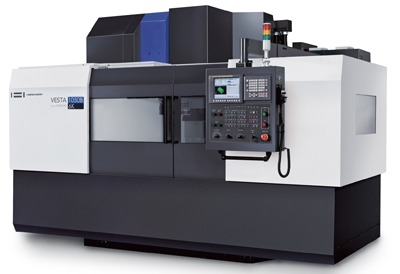
Hwacheon Machinery offers several machines well-suited to demanding oil and gas industry, aerospace, die mold requirements, including its VESTA 1050B vertical machining center.
The VESTA line is designed for heavy-duty machining. Wide, hand-scraped, four-box guide ways in the Y axis and wide box ways in the X and Z axes help maximize machine rigidity. A two-speed gear-driven spindle with integrated drive provides stable high-speed cutting and high torque values. All Hwacheon spindles are oil-cooled, including the gear box, to minimize thermal displacement and promote long spindle life.
The geared headstock machining center is capable of heavy roughing cuts as well as fine finish machining. A true universal machine available with 40 or 50-taper 6000 or 8000-rpm spindles, the 1050B producesµm-accuracy in heavy-duty cuts.
VESTA features a 1150x600x600mm work surface area, travel in X-1050mm (41.34"), Y-600mm (23.62"), and Z-600mm (23.62"), and table load capacity of 1000kg (2205 lbs.). Users have a choice of 24- or 30-tool storage magazines with chip-to-chip tool change times of 5 sec. or less.
Thoughtfully designed machining software components monitor different variables related to work environment and machining conditions then makes adjustments for superior quality results and optimal machining efficiency. This software was specifically developed to increase thermal accuracy and machining performances to the highest level.
Tool load detection (HTLD)software provides real time measurement of tool load ensuring consistent and safe machining. Constantly monitoring tool damage and deterioration for prevention of complete tool failure causing work piece damage, this software ensures accuracy and performance. Such a system will measures tool load very frequently, such as every 8 msecs.
OPTIMA cutting feed optimization software utilizes an adaptive control method to regulate the federate in real time to sustain a consistent cutting load while machining. As a result, cutting tools are less prone to damage and machining time is reduced. The system controls the feed velocity to maintain consistent cutting load. Features include a graphic display of tool load and feedrate, convenient operation using G-code programming, and a number of data sets for specific tool and process control.
Additionally, highly sensitive thermal sensors mounted at various locations in the machine castings where thermal displacement is possible can permit software monitoring and correction of detected thermal displacement.
Spindle displacement control is also possible with standard Hwacheon software. As a spindle rotates at high speed centrifugal forces and heat expand the spindle taper causing error in Z-axis. This axis accuracy is vital to precision mating of die components. In addition to a high precision cooled spindle, software can be used to constantly monitor temperature at a number of points within the spindle assembly predicting thermal displacement. The system can then makes necessary adjustments and effectively minimize thermal displacement, preventing Z-axis error due to taper expansion as the spindle rotates at high speed.
Contact Details
Related Glossary Terms
- G-code programming
G-code programming
Programs written to operate NC machines with control systems that comply with the ANSI/EIA RS-274-D-1980 Standard. A program consists of a series of data blocks, each of which is treated as a unit by the controller and contains enough information for a complete command to be carried out by the machine.
- feed
feed
Rate of change of position of the tool as a whole, relative to the workpiece while cutting.
- machining center
machining center
CNC machine tool capable of drilling, reaming, tapping, milling and boring. Normally comes with an automatic toolchanger. See automatic toolchanger.
- process control
process control
Method of monitoring a process. Relates to electronic hardware and instrumentation used in automated process control. See in-process gaging, inspection; SPC, statistical process control.







